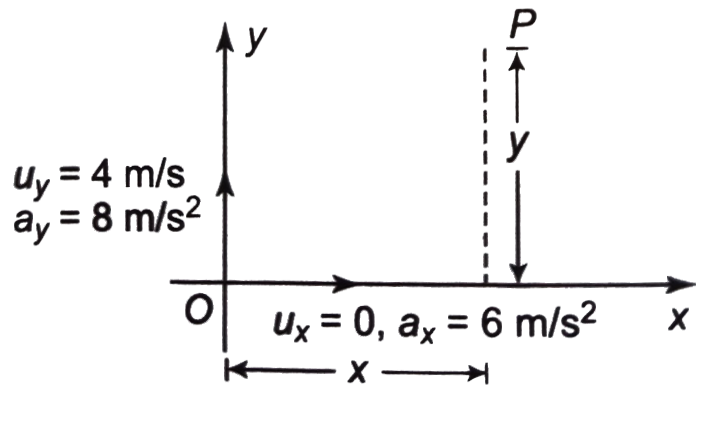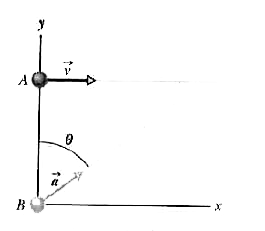A particle is given velocity 4m/s along the positive y-axis subjected to constant accelaration 10m/s2 at 53∘ with the x-axis. Find the distaplacement of a particle along the coordinate axes after 3s.


x : (constant acceleration): x=uxt+12axt2
=0+12×6×32=27m
y : (constant acceleration): y=uyt+12ayt2
=4×3+12×8×32
=12+36=48m
Coordinates of particle after 3s=(27m,48m)
Topper's Solved these Questions
Similar Questions
A particle is given velocity 3m/s along the positive x-axis subjected to constant accelaration 4m/s2 along the positive y-axis. Find the distaplacement of the particle in 2s and trajectory followed by the particle.
View SolutionAt t=0, the particle is at the origin and its velocity is 10m/s at an angle 37∘ with the x-axis. The particle moves in x−y plane with a constant acceleration of 1m/s2 along the y-axis. Find the magnitude and direction of the velocity after 2s.
View Solution
Knowledge Check
- Question 1 - Select One
A particle constrained to move along x-axis given a velocity u along the positive x-axis. The acceleration ' a ' of the particle varies as a = - bx, where b is a positive constant and x is the x co-ordinate of the position of the particle . Then select the correct alternative(s): .
AThe maximum displacement of the particle from the starting point is u√bBThe particle will oscillate about the originCVelocity is maximum at the originDGiven data is insufficient to determine the exact motion of the particle. - Question 2 - Select One
Three particles starts from origin at the same time with a velocity 2ms−1 along positive x-axis, the second with a velocity 6ms−1 along negative y-axis, Find the velocity of the third particle along x=y line so that the three particles may always lie in a straight line.
A−3√3B3√2C−3√2D2√2 - Question 3 - Select One
A particle moves along a straight line parallel to x-axis at a distancce d=3m from it, with constant speed of v=3m/s. Another particle stats from the origin with constant acceleration a=4m/s2 at an angle θ with y-axis along a straight line at the instant the first particle crosses y-axis. Find 'theta' such that the two particle collide.
 A0∘B30∘C45∘D60∘
A0∘B30∘C45∘D60∘
Two particles are moving along x-axis. Particle-1 starts from x=−10m with velocity 4m/s along negative x-direction and acceleration 2m/s2 along positive x-direction. Particle-2 starts from x=+2m with velocity 6m/s along positive x-direction and acceleration 2m/s2 along negative x-direction.
(a) Find the time when they collide.
(b) Find the x-coordinates where they collide. Both start simultaneously.View SolutionA particle is moving along a straight line along x-zxis with an initial velocity of 2m/s towards positive x-axis. A constant acceleration of 0.5m/s2 towards negative x-axis starts acting on particle at t=0. Find velocity (in m/s) of particle at t=2s.
View SolutionAt time t=0, a particle is at (2m,4m). It starts moving towards positive x-axis with constant acceleration 2m/s2 (initial velocity=0). After 2 s, an additional acceleration of 4m/s2 starts acting on the particle in negative y-direction also. Find after next 2 s.
(a) velocity and
(b) coordinates of particle.View SolutionA particle moves with a velocity (3i+4j) m/s from origin.The displacement of particle along line x=y after two seconds will be:
View SolutionIn Fig. 4-28, particle A moves along the line y = 30 m with a constant velocity →v of magnitude 3.0m/s and parallel to the x axis. At the instant particle A passes the y axis, particle B leaves the origin with a zero initial speed and a constant acceleration →a of magnitude 0.40m/s2. What angle θ between →a and the positive direction of the y axis would result in a collision?
 View Solution
View Solution

